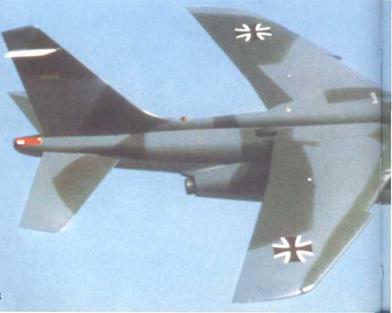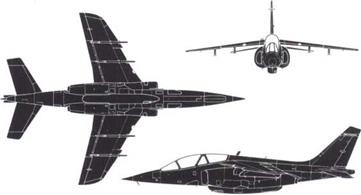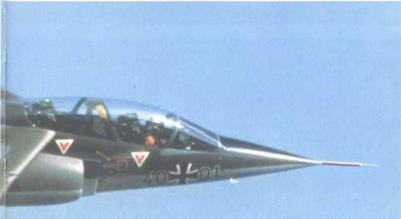Dassault/Breguet Dornier Alpha Jet
Alpha Jet
Origin: Jointly Dassault/Breguet, France, and Dornier GmbH, W Germany, with assembly at each company.
Type: Two-seat trainer and light strike/reconnaissance aircraft.
Engines: Two 2.9761b (1350kg) thrust SNECMA/Turbomeca Larzac 04 two-shaft turbofans.
Dimensions: Span 29ft 11 in (9-12m): length (excluding any probe) 40ft 3Jin (1 2-29m); height 1 3ft 9in (4 2m).
Weights: Empty 6,944lb (3150kg): loaded (clean) 9.920lb (4500kg), (maximum) 15,4321b (7000kg).
Performance: (clean) maximum speed 576mph (927km/h) at sea level, 560mph (900km/h) (Mach 0-85) at altitude; climb to 39,370ft (12,000m), less than 10 minutes: service ceiling 45,930ft (14,000m); typical mission endurance 2hr 30min; ferry range with two external tanks 1,510 miles (2430km).
Armament: Optional for weapon training or combat missions, detachable belly fairing housing one 30mm DEFA or 27mm Mauser cannon, with 125 rounds, or two 0 50in Brownings, each with 250 rounds; same centreline hardpoint and either one or two under each wing (to maximum of five) can be provided with pylons for maximum external load of 4,8501b (2200kg), made up of tanks, weapons, reconnaissance pod, ECM or other devices. History: First flight 26 October 1973; first production delivery originaljy to be early 1 976, actually late 1978.
Users: Belgium, Cameroun, France, W Germany, Ivory Coast, Nigeria, Togo.
 |
Development: Realisation that the Jaguar was too capable and costly to be a standard basic trainer led to the Armee de I’Air issuing a requirement for a new trainer in 1967. The chosen design was to be capable of use in the light ground attack role, in which the Luftwaffe had a parallel need for an aircraft. On 22 July 1969 the two governments agreed to a common specifi-
|
|
Above: Three-view of Alpha Jet prototype with armament.
cation and to adopt a common type of aircraft produced jointly by the two national industries. After evaluation against the Aerospatiale (Nord)/MBB E650 Eurotrainer, the Alpha Jet was selected on 24 July 1970. Aircraft for the two partners are nearly identical. France makes the fuselage and centre section and Germany the rear fuselage, tail and outer wings. SABCA of Belgium makes minor portions. Engines, originally shared by two French companies (see above), are being produced in partnership with MTU and KHD of Germany, plus a small share by FN of Belgium. Trainer aircraft are assembled at Toulouse (France) and attack versions at Oberpfaffenhofen (Germany). Decision to go ahead with production was reached on 26 March 1975. It was expected at that time that France and Germany would each buy 200, and that Belgium would buy 33. but the programme has slipped by more than two years, resulting in increased costs. In 1979 full production was achieved.
Below: After prolonged delays the Alpha Jet finally got into full service in late 1978, with the specially equipped light attack version for the Luftwaffe following in late 1979.
|
|
|












